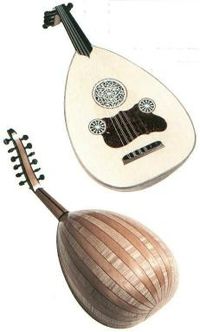The oud is a pear-shaped, stringed instrument similar to a lute used in traditional Middle Eastern music and East African music.
The words "lute" and "oud" are both derived from Arabic العود (al-ʿūd, literally "the wood"). Gianfranco Lotti suggests that the "wood" appellation originally carried derogatory connotations, because of proscriptions of all instrumental music in early Islam.
The prefix al- (meaning "the") in al-ʿūd was discarded by the Turks who then transformed the word ʿūd (consisting of the Arabic letters ʿayn-wāw-dāl) into ud because the sound represented by the Arabic letter ʿayn is not present in the Turkish language.
The oud was most likely introduced to Western Europe by the Arabs who established the Umayyad Caliphate of Al-Andalus on the Iberian Peninsula beginning in the year 711 AD. Oud-like instruments such as the Ancient Greek Pandoura and the Roman Pandura likely made their way to the Iberian Peninsula much earlier than the oud. However, it was the royal houses of Al-Andalus that cultivated the environment which raised the level of oud playing to greater heights and boosted the popularity of the instrument. The most famous oud player of Al-Andalus was Zyriab. He established the first music conservatory in Spain, enhanced playing technique and added a fifth course to the instrument. The European version of this instrument came to be known as the lute - luth in French, laute in German, liuto in Italian, luit in Dutch, (all beginning with the letter "L") and alaud in Spanish. The word "luthier" meaning stringed instrument maker is also derived from the French luth. Unlike the oud the Europen lute utilized frets (usually tied gut).
The History of the Oud
"The transfer of terms for lyre and lute appears more subtly in the myth of the invention of the ud which has been handed down in two variants from the 9th and 10th centuries, the first being Iraqi (Robson, 1938) and the second Iranian (Mas'udi, 1874). They say that the ud was invented by Lamak [sixth grandson of Adam], a direct descendant of Cain; on the death of Lamak's son, he hung his remains in a tree, and the desiccated skeleton suggested the form of the ud. The myth attributes the invention of the mi'zaf (lyre) to Lamak's daughter." (Stanley Sadie: The New Grove Dictionary of Musical Instruments, vol. 3, p. 688) Other sources suggest other interpretations such as; God gave to the sons of Cain the faculty of making musical instruments, Lamak invented the lute, ud, Tubal the drum daff or tabl, Dilal (the daughter of Noah) the harp, mi'zaf, and Lot's people the pandore, tunbur. (Simon Jargy: program notes from Munir Bashir's L'art du ud CD)
"The ud first appears in Mesopotamia during the Kassite period (1600-1150 B.C.) with a small oval body." (Harold G. Hagopian: program notes from Udi Hrant Kenkulian CD) "It was the favorite instrument of the Sumerians and the Assyro-Babylonians." (Simon Jargy: program notes from Munir Bashir's L'art du ud CD) The ud, in Pharaonic Egypt was known as nefer, also appears in the "tomb of Sen-Mut, a tutor of Princess Neferura, who exercised great influence over the arts during the reign of Queen Hatshepsut from 1501 to 1479 B.C." (program notes from H. Aram Gulezyan's The Oud CD) "A larger variety, similar to the instrument's present day dimension, appeared in a relief at Alaca Hoyuk in Anatolia dating from the Hitite New Kingdom (1460-1190 B.C.)." (Harold G. Hagopian: program notes from Udi Hrant Kenkulian CD)
"In the 9th century, Mawardi, the jurist of Baghdad, extolled its use in treating illness, a principle allowed and defended in Arab Spain by the 11th century theologian Ibn Hazm. The symbolism lived on until the 19th century: 'the ud invigorates the body. It places the temperament in equilibrium. It is a remedy ... It calms and revives hearts' (Muhammad Shihab al-Din: Safinat al-mulk, p. 466) ... In any case it was predominantly in the secular usage that the ud made its mark, as the only kind of accompaniment to a form of responsorial song known as sawt, according to written tradition (the Kitab al-Aghani of al-Isfahani) and oral tradition (Tunisia and the Arabian Gulf).
The emergence of the ud on the stage of history is an equally complex matter. Two authors of the end of the 14th century (Abu al-Fida, and Abu al-Walid ibn Shihnah) place it in the reign of the Sassanid King Shaput I (241-72). Ibn Shihnah added that the development of the ud was linked to the spread of Manicheism, and its invention to Manes himself, a plausible theory because the disciples of Manes encouraged musical accompaniments to their religious offices." (Stanley Sadie: The New Grove Dictionary of Musical Instruments, vol. 3, p. 688) Reaching China, an oud like Chinese instrument, pipa featured in instrumental ensembles of the Chinese Han Dynasty (206 B.C.). Later in Japan, it evolved into an instrument called biwa. It also reached Russia evolving into balalaika, and also to Indonesia where it evolved into gambus. "But the movement's centre was in southern Iraq, whence the ud was to spread towards the Arab peninsula in the 7th century. However, the texts mentioning the introduction to Mecca of the short-necked lute as the ud were all written in the 9th and 10th centuries." (Stanley Sadie: The New Grove Dictionary of Musical Instruments, vol. 3, p. 688) "The founder of the ud school of Baghdad [in the 9th century], Ibrahim al-Mawsilli and, above all, his son Ishaq al-Mawsilli were among the most esteemed and honored people in the [Abbasid Empire] ... The influence of the grand master, Ishaq, of Baghdad was such that one of his most brilliant disciples, Ziryab [jealousy and intrigue on the part of his teacher, Ishaq drove Ziryab to seek refuge in Andalusia], transported the art of the ud to the banks of the Guadalquivir in Moorish Spain, at the far extremity of the Empire." (Simon Jargy: program notes from Munir Bashir's L'art du ud CD) "When [Ziryab] arrived in [Moorish] Spain, the cities of Cordoba, Seville and Granada were centers of great cultural, artistic, and religious activity. These centers, under the inspiration and influence of the Sufis, were to have a tremendous impact on medieval Europe. Once settled at the court in Cordoba, Ziryab set about introducing the concepts of a new music, drawn from Greek, Persian and Arab elements, that was to influence deeply the foundation of European classical music." (Kavichandran Alexander: program notes from Hamza El Din's Eclipse CD) Then the ud was brought to Venice through coastal trade.
Eventually "the ud was introduced into western Europe by the Knights Templar returning from the Holy Land and by the Troubadours from Provence. Having reached the Troubadour from Muslim Spain, this instrument was to play a crucial role in the establishment of the Romantic Courts. The poetry, music, and ideals that ensued from this great endeavor became the infrastructure upon which the Renaissance was built. Brought into the British Isles, the ud was transformed in the Elizabethan period into the western European lute."
Regional types of Oud
The following are the general regional characteristics of oud types in which both the shape and the tuning most commonly differ:
* Arabic ouds:
* Syrian ouds: Slightly larger, slightly longer neck, lower in pitch.
* Iraqi (Munir Bashir type) ouds: Generally similar in size to the Syrian oud but with a floating bridge which focuses the mid-range frequencies and gives the instrument a more guitar-like sound. This kind of oud was developed by the Iraqi oud virtuoso Munir Bechir.
* Egyptian ouds: Similar to Syrian and Iraqi ouds but with a more pear shaped body. Slightly different tone. Egyptians commonly string only the lower courses up to 'g'. Egyptian Ouds tend to be very ornate and highly decorated.
* Turkish| Greek style ouds ("ud,ούτι") (Includes instruments found in Armenia and Greece): Slightly smaller in size, slightly shorter neck, higher in pitch, brighter timbre. It's known as outi in Greece and was used by early Greek musicians.
* Barbat (Persian Oud): smaller than Arabic ouds with different tuning and higher tone. Similar to Turkish ouds but slightly smaller.
* Oud Qadim: an archaic type of oud from North Africa, now out of use.
Although the Greek instruments Laouto and Lavta appear to look much like an oud, they are very different in playing style and origin, deriving from Byzantine lutes. The laouto is mainly a chordal instrument, with occasional melodic use in Cretan music. Both are always fretted (unlike the oud).
sources: wikipedia and Oud Homepage




